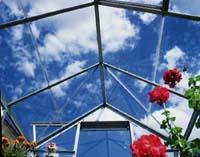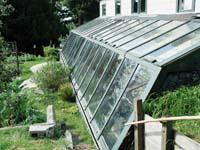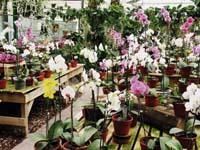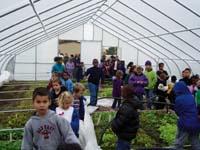Aitor Artetxe: "We have learned a lot from greenhouses in northern Europe"

They have changed a lot, especially in terms of the technology used in greenhouses. The greenhouses more visible 20 years ago were very simple tunnels. The aim of these tunnels was to extend one or two months in the summer and thus harvest. Today, greenhouses are used both for winter and summer, and are facilities to achieve suitable conditions for vegetation in both winter and summer. The term we should use today is controlled agriculture. The term English has also changed. Before they were called hothouse and now they were called greenhouse.
In Euskal Herria we have learned mostly from Northern Europe, where we use the same technology they use. Here we have glass greenhouses, as in France, Holland and Belgium. Mediterranean greenhouses are used in Italy and Spain. These are made of different materials. At the state level, the greenhouses of our environment use more technology than those of the peninsular south and our performance is greater than theirs. No production, kilos, but yes yield per square meter. This is so, especially because we have higher prices here.

The most widely used material to cover greenhouses is polycarbonate. Secondly there would be polyethylene or plastic film and third the glass. The cheapest is plastic and the most expensive glass. And as with almost all things, here the best is the most expensive and the cheapest the worst. The glass has the longest duration, has better thermal properties and allows the best passage of light. So far polycarbonate and methacrylate have been used for their intermediate properties, but due to the increase in oil prices, their price has increased considerably and today the difference between the price of polycarbonate and glass is lower. The structures are usually made of steel and aluminum. In glass greenhouses aluminum is very important as glass is placed between aluminum.
What we do is give each garbage can what it wants. It is the work of engineers. We analyze the most suitable structure to produce such products in these situations. We value profit and profitability and express our opinion. We also take into account the investment capacity of each hamlet. For us the glass greenhouse can be the most suitable and profitable in the long term, but if there is no investment capacity, we must settle for a plastic film or choose another halfway.
There is something, there is, but in Euskal Herria little work has been done. As for plastics, the problem here is that there are very few greenhouses, that is, there is little plastic. Therefore, it is not profitable to put a company to treat this plastic. Almería has between 5,000 and 6,000 hectares of plastic. That's a lot. Here we have about 100 hectares. There are companies that recycle plastics. The reuse of the structure is simpler, in short it is about sending the metals to a scrap. Normally a greenhouse can last between 15 and 25 years. In fact, good conservation can significantly increase the duration of a greenhouse. A couple of years ago we conducted research for the Basque Government. The study explained the fate and treatment of greenhouse plastics. We elaborate a Rules of Conduct for the management of these plastic waste generated in agriculture, not only in greenhouses. Therefore, there is responsibility on the subject.

Inside the greenhouses are usually temperate and measure humidity. Other factors that are controlled are light and the amount of CO 2. In the case of plants and flowers it is important to regulate well the light entering the greenhouse. It is advisable to reduce the brightness that penetrates the greenhouse sometimes, while decreasing the temperature. On the other hand, some plants, such as tomatoes, are artificially subjected to CO 2 for better growth.
Because the plant needs three things to grow: water, sun and CO 2. Of course, oxygen too, but at the base you need these three things to realize and grow photosynthesis. Around us we have between 350 and 400 parts per million CO 2. CO 2 quantities between 1,000 and 1,500 parts per million are suitable for the plant. In a city or industrial place we will have 450 parts of CO 2 per million, but that is little for the plant. Therefore, CO 2 is artificially introduced into greenhouses. In Euskal Herria two systems are used. The first is to introduce the clean CO 2 into bottles inside the greenhouse. The second is the cogeneration system. A small thermal power plant is used to generate electricity and heat water. Water is used to heat the greenhouse. The smoke is filtered and CO 2 is used inside the greenhouse.

The most widely used gold system in greenhouses is drip irrigation for the production of lettuce, tomatoes and peppers. Downstream irrigation systems are used in flower nurseries to simulate seasonal rainfall. Irrigation systems have also been substantially modified since the introduction of the hydroponic system. In hydroponic productions plants are not produced in the soil. They are inserted in sacks with perlite, rock wool, pine bark or peat. Due to lack of land, the fertilizer is introduced together with the irrigation system. This system considerably improves production. Therefore, in terrestrial productions fertilizers are now incorporated into water. The simplest system is a hydraulic pump that collects the fertilizer of a water tank and delivers it semi-automatically to the plant. The most complex systems incorporate sensors to measure the pH, conductivity and amount of water compost, and a computer program determines the most suitable compost mixture.
No doubt. If we make a comparison, the hydroponic system is like hospital serum. Through serum, the patient gets the necessary components at the time. The chemical components required by the plant in the hydroponic system are immediately placed next to the root in suitable humidity conditions.
The first factor that is controlled with the computer is temperature. A sensor is placed in the greenhouse itself. This sensor sends the signal to the computer and, taking into account all the variables, the program determines whether the greenhouse windows should be opened or closed. And that also does it automatically. In the interior of the greenhouse the daily temperature is higher than that of the night, but in any case the important thing is to control well the daily and night cycle. For example, when the plant is small, due to its high sensitivity, it will need warmer temperatures. As with children.

Yes. Today it is possible to control from our office the greenhouses we have in China. They have their coordinator in China and we connect to their computer from our office. We monitor your facilities and if you encounter any problems, turn on the alarm.
Buletina
Bidali zure helbide elektronikoa eta jaso asteroko buletina zure sarrera-ontzian











